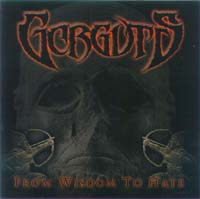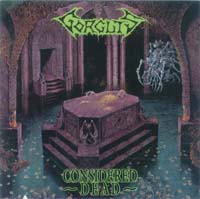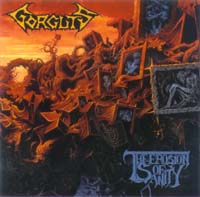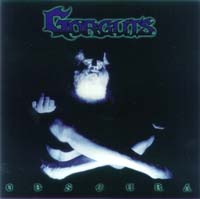Gorguts
Gorguts - The Erosion of Sanity (1993)
Gorguts - Obscura (1998)
Gorguts - From Wisdom to Hate (2001)
Review: As the death metal genre expanded it became clear that the aesthetic created by its presence offered more than was being exploited by mostly direct music with a granular conception of structure assembled in rhythm from elements often expressing consistency more than an articulation of a substructure specific to some section of the song; from this perspective, there was either the conventional methods of making something progressive (jazz, rock) or an attempt to find a new voice in metal using ancient knowledge and current communications theory and method. In these pieces which carve grandeur from the tonal space they conquer with articulate and convoluted intensification of development through recombinant rotation of an evolving series of structures, atmospheres expand through rest and evenly divided foundational battery of thunderous chordblast and percussion in alternation throughout the exegesis of theme which at its core, reveals a melody growing from its introduction to a conflict and sensibility in fusion through a final nihilism matching the aesthetic of drums and open chording rigorously paired against roaring power chord ripping riff tirades.
Within the organic and gently-moving framework of passages unfolding to reveal possibilities within each other leading to a fundamental gap causing space and time to be presented in music, Gorguts weave an intricacy of delicate but essential harmony creating a presence of depth in the music foreshadowing and augmentating the presentation of many views of theme. Impressively precise in lead guitar stitching a pattern over changing power chord fluidity in texture illustrating mood or in the low-end formulations of indulgently lush harmony and thematic conclusion in dissonance, this music decodes its motif structures in appropriately abrupt shifts in architecture to reveal affinity for resolution in perplexing but spiritedly exact phrase unified in modal and structural conclusion to introduction of fundamental ideals in overture to motif explication. Vast in its sense of overall dynamic to each piece in the placement of variation in sonic or tonal intensity, this music expresses a heaviness sensu Black Sabbath in which the relentlessness of motion in sound toward a central point of destruction, in unity with rhythmic breakdown of structure in method of rendering phrase, levels each piece to where it began from which the dark motion must again originate.
Powerful in command of emotion through mood and sensibility of velocity in a space defined between tones of a fundamental phrase, and exploited through the properties of each phrase as it harmonizes or alienates resonance through its development, riffs and passages influence through shape of tonal motion a relevance to initial definitions within the piece, bringing a sense of harmony in structure of unified form as wrought from resonance and rhythmic articulation expressed through thematic narrative in songwriting defining the poetic contents of each work. These are morbid death metal themes in the sense of existential alienation meeting the willpower to self-create, as expressed in metaphorical verbiage of the decomposition of body and soul in entropic inevitability.
Highly influential though also highly hated by the mainstream crowd (Cannibal Corpse, Pantera) this brave crew of creative minds from Canada mastered the arts of basic underground metal and expanded it to a sense of neoclassical composition as rendered through the shorter song format and more explosive instrumentation of death metal. For this reason it is revered and hailed by many creators within metal and other genres who wish to push limits and attention spans to the point of epic awareness.
Review: To develop their progressive music further but in the style of bands such as Deicide make it correspondingly aggressive and feral in application of sound through riff texture and percussive emphasis, Gorguts sought a larger application and used their trademark division of melody to render thunderous death metal through doubled introduction of themes in layers corresponding to a motif emerging for development and deconstruction in the poetic contraposition of internal differences in resonance of thematic structure in union. Surging, sometimes gently pausing, often exploding into blasts or sudden changes in rhythm, and constantly cycling like a pattern of death returning to recombination, in the lead guitar work and rushing power chord tirades of Gorguts a balance of violence and sense is found. Inclined more toward pure structure than denser harmonies of their previous album, this work evokes the most intense instrumentation and dynamic presence yet seen from Gorguts, with rumbling low-end blasts etching a sensibility alongside line art of lead riffing in music that expands along motif eruption to differing textures of overall piece dynamic entirely, aggregating into a delivery of theme accented by acoustic and piano interludes that are melodically coherent with the pieces following and often accompany detailed and percussive death metal riffwork throughout songs. Hoarse and rigid vocals urge forward the twisting devolution of pattern into origins for re-creation in new form, a curving recursive insurgency that echoes evolutionary process in natural environments through its organic assembly of structures and through narrative, their mutations and fusions. Division is present in themes and their ressurrected shadows appearing throughout these delicately inflected pieces rendered in pounding aggression of luminous heaviness eroding all sense from reality to replace it with a more coherent logic.
Lead guitars echo major themes and aim for an obscurist view of tone and rhythm to self-reduce in melodic phrasing in the style of the doom metal contributing a founding influence to much of the aesthetic here in use. Brilliantly precise musicianship and alacritous endurance of hardship to evoke complexity in form and awkward, unlikely, unwieldy structures brought to life through a will toward melodic coherence through the piece anchor essential motifs. Drums understate themes while emphasizing an internal crossover in the style of early work from Darkthrone, in a thunderous death metal context, while songwriting is reminiscent of classical works transported to a postmodern future of apocalyptic machinery at war. If savage, it is at an underlying level peaceful in its study of intention as expressed through design in patterning as contexted in structure reflecting an emotional response to a logically perceived world enjoyed both in existential resonance and a hope for incarnate vision of the creative.
While death metal slumbered, this band invented and rolled forward to create a vast and forward-thinking ideology of music as expressed in work of grandeur in conception and execution, with a gentleness to its innovation that belies the explosive and tempestuous nature which crafts these subtly building gestures flowering in multiple motions within the same evolution of action, becoming in their dissent and dissonance to reality a portion of the darkness that in removing the nonfunctional, primes the resurgent will toward life.
Review: Taking metal's exploration of chaos toward a further point of existence than it has previously occupied requires a breakdown of basic song construction into something which distinguishes itself from the layers of complexity of the same essential idea, over which different degrees of embellishment normally achieve little more than an aesthetic progressivism. Gorguts have refined the metal art of songwriting along the axis of melody in a plausible interpretation of post-black metal underground musicology and have, in order to reveal the face of the schizophrenic reality lyrically described as a balance between peaceful harmony of dissonant elements and calming disharmony of like elements, embedded their sinuous virus of melody in towering structures of variation encompassing the extremities of metal hereto known and styles from other genres within a package presenting the metal vision in a clarity never before achieved: a chaotic universe in which structures find a similarity independent of immediate categorization by demonstrating similarity in informational content and its relevance to the core of each system, a simple ruleset based upon a fractal arising from an elemental opposition.
High speed counterpoint baffling chord structures buttressed by recursion, tonal centering through droning cyclic melted sound emergence, ragged fugues of dissonant melodies converging toward oblivion, tempos shifting through the elements of one another into each other, cyclic two-hit metal percussive structures and free-form progressive harmonic jamming are packed into these songs as overhead to the essence of each, which no matter how aesthetically different it appears at first listen reveals itself as fundamental Gorguts when the emergent melody encoded within begins to find form in the various aspects of its decomposition showcased by differentiation structures creating a vast tonal motion in their evolutionary journey from the point of chaos to clarity. The same voice that crafted the strength within the sturdy structures of death metal on two previous albums speaks through the chaos on this release with a newfound power in its ability to fuse what to most will seem like a salad of riffs juxtaposed for their difference rather than similarity.
Throughout the album the use of dissonance and difference is profound; at any given point, one or more instruments is probably working through something jarringly contrapuntal to what preceded it, whether rhythmic or harmonic or both. Riffs will repattern themselves from the other end of their tonal spectrum while drumbeats will collapse inward to pull forth their own nemesis and reintegrate it toward the shifting collection of dominant patterns through which each song moves to a conclusion. As always, tasteful use of open chords and harmonic complexity in non-standard chords allows the painter a wider range of color upon which to set the rigors of line; a richness of tone provides a space for melodies to motion tonal points through a twisting set of harmonic boundaries which resemble DNA more than any other music seen before in this genre. And over all of it the husk of a hoarse roar that is Luc Lemay's lead vocal shudders with eerie precision despite the quicksand of rhythm and phrase over which it moves.
Every instrument is played to an extreme of technicality not found in the perfection of each fretted note, but in the ability to weave complexity out of any element of all elements at any given moment in the song, with an aplomb for varied technique and subtlety. Composition is amazing; this album takes the promise of Morbid Angel's Blessed Are the Sick and combines it with the chaotic multiplexing first gestured at by music like Suffocation or Deeds of Flesh, unifying it along a melodic evolutionary language straight out of the innovators of classical or harmolodic jazz, having learned from the nihilistic reliance on the dynamic relationships of notes innovated by wildcat geniuses like Burzum or Darkthrone. Furthermore behind all of what is created lies a profound understanding of the nature of darkness in the universe, from chaos to mortality and beyond, in an unflinching eye which can see the fusion of destruction and harmony in one and the same; the melodies that are simultaneously harsh and spiritually uplifting in their complexity, gentleness and relevance create their own will to freedom in the listener's mind. While to the ear trained in current music this may seem on the edge of unlistenable, to those with an aural line to the future this is the pure beauty of open potential waiting to explode.
Review: In waves passing through cycles that evolve a subconscious theme into articulation, songs of this album sweep through a palette of vivid sound that melts through the rigid architectures of rhythm that comprise the riff lexicon as rendered into linearity as telegraphic precise structure etched through an enwrapping rhythm and songwriting that emphasizes somewhat conventional structures resulting in a highly listenable album. Like Deeds of Flesh with a Ph.D., this album could be explained as a larger take on what Voivod or Immolation within the Cryptopsy sound in the context of expressing sublime melody as first projected on "Obscura" by this band.
Churning and percussive in the classic North American style this album also detours with an offbeat change into broken-rhythm, abstracted pieces revealing portions of theme. Consistency is much higher than the previous Gorguts album, calling to mind the one previous with an exercised sense of listener dynamic and the will to craft structures which, revealing their mainly classical basis, often operate within the same key and use structure as contrasted to the matrix of patterning within each piece to create musical change as an alternative to the shifting of tone centers and jazz flavorings of the last album. Intensely practiced and diligently sparse musicality underlines concept with proof of ideal and a handful of conventional death voices with the inflective variation of black metal furnishes an essential element of the genre while encouraging progressive experimentation.
1. Inverted (4:22)
2. Behave Through Mythos (5:10) 
3. From Wisdom to Hate (5:06)
4. The Quest for Equilibrium (6:47)
5. Unearthing the Past (5:02) 
6. Elusive Treasures (6:19)
7. Das Matyrium Des... (4:33)
8. Testimonial Ruin (3:20) 
Length: 40:41

Copyright © 2001 Olympic
The enlightened use of blasting and driving technical structures featuring tempo-driving offbeat double-hit drumming and the incorporation of structure behind the melody using dissonant chords provides a range of data types for theme, which built around central ideals is distributed chaotically although cautiously through varied renderings such as flutterstrum guitar melody behind a charging lead line and subtle harmonies anchoring layers throughout the work, fuels themes of conflict between a stagnation with the sense of conflict with world itself and the desire to discover more of the faint coherence emerging through the chaos. Dynamic variation has been reduced and development of linear theme intensified as a result in these almost operatic phrases gliding through the battering, pulverizing roaring guttural chaos as the operative minds inside each piece seek a balance with themselves and their perception of a world worth hating.
Obviously cautious after the ambitious and for some unlistenable "Obscura," Gorguts proceed with a fusion of current death metal, older styles for this band, and the more communicative ideas from experimentation on the previous album. Knowledge integrated, new output produced: smoothly connected, memorable in distinctive songwriting individual to each tune, of enlightened backend conception and melodic-thematic integration while of foreground conscious of the listener: physical motion evocative intricacy of thunderous code iterating the cycles of equilibrium in existence, should one choose to remain a conscious being. As if in reply, through the raw joy of music and passion in structure this album is an argument for consciousness.


